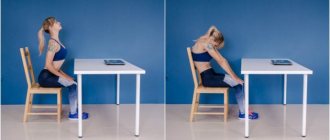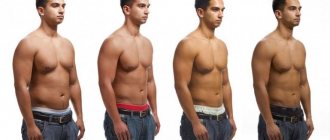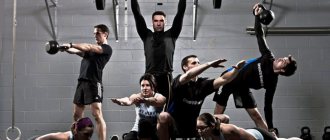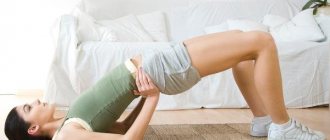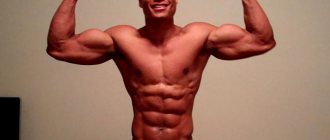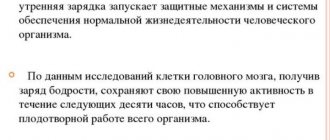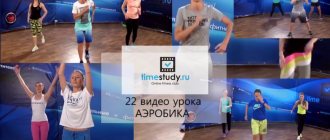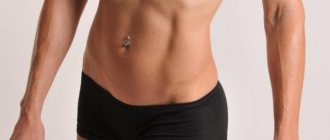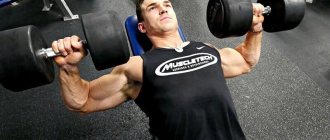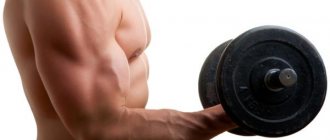- October 9, 2018
- Workouts in the gym
- Yana Yanovskaya
Exercising helps keep your body in shape. If you combine different types, you can get a complex result. There are more than a hundred names of exercises in the gym, which are performed both with the use of special equipment and with free weights.
Power training
The goal of this type of exercise is to develop muscle strength as much as possible. Do you want to see sculpted muscles in the mirror? That way. However, you will have to work hard. And the result will depend not only on your perseverance and willpower, but also on how correctly the exercise program was drawn up, whether the diet and daily routine were followed. Strength training has long turned into a lifestyle and has become a whole science, which cannot be mastered without studying the basics of biology.
We list the main types of training of this type:
- Gaining muscle mass.
- Strength endurance and muscle definition.
In each of these subspecies there is an incredible variety of “pumping” programs. Usually they are developed strictly individually, depending on the physiological characteristics of the practitioner’s body.
The main types of training on strength training equipment come down to training different muscle groups: back, pectoral, legs, triceps, biceps, shoulders, abs. At the same time, a training plan is drawn up, where exercises for different types of muscles are grouped. It’s simply impossible to do quality work on your entire body in one workout.
History of the creation of sports simulators
Depending on the size and type of the gym (someone trains in a large, ultra-modern gym on several floors, and someone in an ordinary basement with basic equipment), the set of structural contents can differ significantly. Nevertheless, the “gentleman’s” basic set, represented by handy equipment and exercise equipment, is the same almost everywhere. Therefore, it makes sense to understand the basic minimum, which is found in almost any gym.
Before you begin to study such inventions, you need to know a little background about their origin and further evolution. Modern people have a wide variety of devices at their disposal that can make the body fit and athletic. However, this was not always the case, and our ancestors had to pump up different muscle groups by simply running over hilly terrain and carrying loads. But the rapid development of science in the field of health improvement and physical activity has led to the active improvement of the new industry.
So, the description of the simulators mentions that they are mechanical or electrical devices that are capable of simulating a number of different loads and situations. As for sports simulators, they are designed to perform special exercises for pumping and developing the muscle base, training the cardiovascular system, as well as the balanced functioning of various muscle groups.
In 1864, Wilhelm Zander (a famous doctor) founded the Institute of Sports Training Equipment in Stockholm, where 27 of his own developments appeared at once. These models were particularly diverse and were presented:
- A mechanical aerobics horse that is attached to a motor that sets the rhythm.
- Devices for squats and lunges.
- Power frames.
- And much more (for deadlifts and bench presses).
Cardio training
It is impossible to imagine the types of workouts in the gym without mentioning the cardio zone. But exercises on these machines have a completely different purpose; you cannot build up muscles on them. But they are much healthier for health. Let's list the benefits of such exercises:
- Increased endurance.
- Strengthening the cardiovascular system.
- Increased lung capacity.
- Maintaining blood pressure levels.
- Reducing cholesterol.
- Improved overall well-being.
Cardio training is often combined with strength training and carried out in parallel.
What exercise machines are cardio-type? There are not many of them, but they are in any sports club:
- Treadmill.
- Exercise bike.
- Orbitrek (elliptical trainer).
- Stepper.
- Rowing machines.
This type of physical activity is ideal for those who want to stay fit and maintain their health.
Warm-up and cardio training
The simplest and most accessible set of exercises on simulators must begin with a mandatory warm-up:
- elliptical trainer;
- treadmill;
- rowing machine.
During such classes, before the main exercises, you can recharge your batteries and activate internal processes associated with muscle work.
Types of training depending on the goal
The types of physical training directly depend on what you want to achieve. So before you go to the gym, understand why you need it. This way you can quickly navigate various training programs, and your efforts will not be in vain.
So, depending on the purpose of the training, there are:
- To build muscle mass.
- For weight loss - the most popular option for summer. And you can’t do it without cardio equipment.
- To increase muscle strength without gaining mass.
- To give muscles definition without gaining mass.
Each of these areas has its own specifics, training schemes, intensity of loads, etc. It will not be possible to achieve results in all areas at once, so you will have to choose one.
What does a multifunctional gym look like?
If you are going to sign up for a gym and have come to the appropriate institution, then before you begin to study the use of exercise equipment, you need to conditionally divide the audience into two groups:
- For men.
- For women.
Representatives of the first group come here to increase their volume and develop endurance. The second is to lose the unpleasant fat layer . Due to this feature, gender division is often practiced in gyms: girls - to the right, boys - to the left. But this doesn't always happen. It is necessary to consider the general, universal case, i.e., the purpose of specific pieces of hardware and units. Basically, all gym equipment can be divided into:
- Sets and designs for fitness exercises that increase the slimness of the figure (step platforms, hoops, dumbbells, gymnastic rollers and balls). Such products are suitable for representatives of the fair half of society, because they do not involve working with heavy weight.
- Exercise equipment. The principle of operation of such devices is to influence different muscle groups with weights.
- Strength equipment (barbells, plates, and barbells).
Simulators can be divided , depending on the task performed, into:
- Cardio exercises (treadmills, orbitracks, cycling machines, etc.).
- Block (equipped with built-in scales that are adjusted using a movable pin).
- Lever (have free weights that “throw” onto the machine).
- Power frames/machines (“name” exercise machines produced by specific inventors).
The last four groups belong to the category of strength training equipment. Most gym goers prefer the individual type of “machine,” but sometimes you can meet a beautiful girl near some kind of weight training machine .
Fitness training
A very popular form of physical activity among women. Fitness is aimed at keeping the body in good shape, achieving good health and maintaining health. Today, the types of fitness training tend to be infinite in number. This type of physical exercise has an incredible number of varieties.
Surprisingly, fitness classes also refer to workouts done in gyms. And all because most types of direction are impossible without auxiliary means - such as dumbbells, fitballs, etc.
Fitness is an excellent option for those who want to work only with their body, are not chasing bulging biceps and want their figure to look toned.
Fitness classes for stretching the body
This is a fairly popular trend today. Such classes are focused not on building and training muscles, but on stretching them. Typically, visits to such training sessions are combined with strength exercises. After all, muscles cannot only be pumped up; they must also be stretched. Otherwise, in old age, you can focus exclusively on visiting doctors and spend your pension on medicine. Which is doubly offensive for those who have spent so much effort on gaining health.
Let us present and characterize the types of stretching workouts in the gym:
- Yoga is a very fashionable fitness trend, whose roots go back to the culture and philosophy of Ancient India. The philosophy of yoga is to achieve inner harmony through improving the body. All exercises of this technique are called asanas. They are aimed at developing endurance, strength, flexibility, improving posture, and accelerating metabolism.
- Pilates is an excellent complex that is suitable even for physically unprepared people. It has virtually no contraindications. Particular attention during training is paid to the muscles of the pelvis, back and abdomen.
- Stretching – aimed at stretching all muscle groups. It is recommended to combine this technique with more serious muscle loads.
- Bodyflex – the basis of this type of fitness is proper breathing. This is a rather unusual workout, since you will have to breathe in an unusual way. Systematic exercises help strengthen muscles, lose weight, and improve well-being.
Functional and strength training
Fitness also includes types of gym workouts aimed at strengthening and developing muscles. Let's list them:
- Shaping is an excellent technique for strengthening muscles, which is suitable even for untrained people. The exercises are very simple, and the effect is achieved through repeated repetitions. Training can be aimed both at reducing the volume of problem areas and at increasing missing roundness.
- Callanetics is a very popular type of fitness aimed at burning excess fat and strengthening the muscle frame. During training, almost all muscle groups are involved in work.
- Strip plastic is perfect for body correction, especially if you want to get rid of “ears” on the hips. The exercises are mainly aimed at developing leg muscles and flexibility.
- Body Sculpt – provides loads on all muscle groups of medium and high intensity. All exercises must be performed with dumbbells or other objects that serve as weights. Training helps increase strength endurance and make muscles more prominent.
SPORT Top 10 exercises I do in the gym
Bench press
“How much do you bench press?” is a classic question when discussing achievements in the gym, which is not surprising. One of the basic exercises that determines overall strength, in addition to squats and deadlifts. And this is one of the few exercises that remains a favorite after years of training. True, now I will not answer the question mentioned above in its traditional form: “How much do you press at a time?” I haven’t worked on repetitions for a long time, I basically stick to the number of repetitions ranging from 8 to 15 . In addition, I perform the classic bench press once a month at most. The rest of the time I work more with dumbbells and in the Smith machine at different bench angles, in a crossover and on parallel bars. For me personally, a simple bench press is not very effective; it works the shoulders more than the pectoral muscles. In general, the working weight of the barbell is 100-110 kg for 8-12 times in 3-4 main approaches. However, this is one of my favorite exercises.
I’ll give you one piece of advice that personally helped me to relieve my shoulders a little when doing the bench press. Bring your shoulder blades together, then your shoulders will be motionless. By the way, this is a powerlifting technique for performing the exercise, excluding the bridge. I don’t use it, because it reduces the range of motion and simplifies the exercise, and for muscle growth you just need a maximum range of motion. Again, a lot depends on the structure and how the muscles are attached. What is good for one person may not be suitable for another. Therefore, lifting weights is an individual sport in which there are no universal tips. You need to try everything on yourself and choose the most effective exercises and principles.
It’s also worth noting that I don’t have any unfavorite exercises as such.
There are simply exercises that need to be done and that work for me, and there are those that I like more and do with special pleasure. Dumbbell Bench Press
I admit honestly, in the past I practically did not load the pectoral muscles with dumbbells at all, considering this exercise to be useless. When I started working out with a trainer, I did it automatically, like it’s necessary and necessary. But gradually I began to really feel the work of the pecs, and much better than during the barbell press. I especially like the options with different bench angles (30°, 45°, sometimes upside down).
Actually, the main progress in the appearance of the pecs (especially in the upper part, in the so-called “collar”) occurred precisely thanks to work with dumbbells.
Here I will add not only bench presses, but also dumbbell flyes. The reason is simple - when pressing dumbbells, the amplitude is greater, plus the arms are not fixed, they move freely, and I can force the pectoral muscles to work, and not the deltoids, while with a barbell they are fixed in the same plane and here my joint structure is a limitation and features of muscle attachment. Bringing hands together in crossover
I do not recommend this exercise for beginners. They are really better off focusing on basic movements. But I highly recommend it to advanced comrades who want to give a certain shape to their breasts. Crossover raises (from top to bottom), arm lifts (from bottom to top from lower blocks), lying down presses - all these exercises allow you to perfectly trim your pecs, define them and give them an athletic shape. It is important to feel that you are working with your chest, and not with your arms or anything else. There is no movement in the elbows, we use only the chest, specially trying to strain them. If at the end of the exercise there is a burning sensation in the target muscle group, then everything is ok - you pumped your pecs, and not something unclear.
What is good about working in a crossover in comparison with a barbell or dumbbells is that the muscles are constantly under tension , including at the extreme point of the exercise, that is, at peak contraction.
In turn, when bench pressing or dumbbells, when the arms are fully straightened, the load from the muscles goes to the joints. This is why some athletes do not work at full amplitude and do not fully extend their arms. Or, with precise control of the muscles, they tense them at the top point on their own, but this is not easy, it takes a lot of practice. An incomplete amplitude can be used by a less experienced person, but, as you understand, the smaller the amplitude, the worse for the development of the target muscle. The goal is to stretch it as much as possible and shorten it as much as possible, which is impossible when working in partial amplitude. Crossover curls
Almost a classic biceps exercise, with the exception that instead of a barbell I use a block. The reason is exactly the same as in the crossover exercises described above - constant load on the target muscle, including during peak contraction. It is important not to move your torso during the execution, but to work only with your hands, placing your elbows slightly forward and fixing them in space.
I also like to do crossover biceps curls while sitting with my elbows on my knees.
A kind of analogue of curls on the Scott bench. Hammer grip dumbbell curls
I don’t know why, but I just love this exercise that trains the brachialis .
This is the brachialis muscle that runs between the biceps and triceps. It is partially responsible for the peak of the biceps, as if pushing it out when the arm is tense in a bent state. Most often I do it sitting, with my elbows resting. Sometimes I work standing, but in this case I have to especially control my elbows so that they do not move. Dumbbell lateral raises
For a long time, there was a problem with training, or more precisely, with pumping up the deltoid muscles - they did not grow at all. True, among the exercises I only did the classics for them, like lifting dumbbells up, the “Arnold press” or the barbell up press while sitting and standing. I achieved visible results only by including various types of dumbbell lateral raises in the program: sitting, standing, lying on your stomach, plus lifting dumbbells forward. I also added other exercises, including lifting a barbell or block in front of you, rotating the disc and several others. But most of all I like the dumbbell lateral raises.
It is worth noting that the exercise is quite complex and there is no need to use a lot of weight when performing it. It is important to feel the target muscle and strain the deltoids, and not your back, arms or anything else. You need to pull your elbows up, imagining as if you are pouring water from two jugs of water. According to the description, everything seems simple, but it took me several months to learn to feel the muscles when working with dumbbells. The most important thing is not to chase heavy weights; they are not needed in the mentioned exercises and can only do harm, completely breaking the execution technique.
Another factor that personally helped me in training my deltoids (as well as my arms) was changing my training split . Previously, it was classic - three times a week with training of the following muscle groups:
- Legs and triceps.
- Back and shoulders.
- Chest and biceps.
As you understand, after a hard leg workout there was no time for triceps, my strength was running out, and I was frankly slacking. The same goes for back training, especially if heavy exercises like deadlifts were included. And for a comprehensive training of the deltas, it is necessary to pump all three beams separately (back, middle and front). Naturally, it was not possible to do this either.
As a result , I added one more training day and scattered the shoulder training throughout the week . The result is a split for Monday, Tuesday, Thursday and Friday, respectively (the rest of the days are rest):
- Legs (4–5 exercises).
- Back (4 exercises) and rear deltoid (it works in all back pulling exercises, so you just need to finish it off with a couple of movements).
- Pectoral (4 exercises) and anterior delta (similarly, in pressing exercises the front part of the delta is worked, so in the end a couple of movements in 3-4 sets of 12 times is enough to get a good effect).
- Biceps and triceps, plus middle deltoids.
Perhaps my experience will be useful to someone, plus do not forget that from time to time the training program needs to be changed, surprising the body, and giving the muscles an additional incentive to adapt and grow.
I personally am thinking of specializing in hands for the winter. I would like bigger “cans”. Block pull to the chest
Another technically quite difficult exercise. At least for me. It was only when I started working with a trainer that I realized that in the past I was pulling the block with my hands and not with my back. How did you understand? Yes, it’s very simple: no matter how much I did this exercise in the past, the next day or every other day my arms hurt, not my back. Or nothing hurt, which happened more often. It very rarely happened that I felt exactly my back. When I really learned to work in the required amplitude and pull with my back, after each workout the strength was felt in the right place.
To perform the exercise correctly, you need to try to pull your elbows down and not bend your elbows . Imagine that your hands are just hooks, and it’s your elbows that pull the block.
By the way, the same rule applies to wide-grip pull-ups - we lift the body using the back, not the arms. But if the goal is to train the biceps, then you can use your hands to pull yourself to the horizontal bar, but then you should change your grip. In the case of a block, it is better to work only with your back. Specifically for the arm muscles, this is a weak load, which falls more on the ligaments and tendons.
Naturally, I do many other exercises for the upper and middle back, but what I like most are the different types of pull-downs.
Deadlift
To be honest, I never liked this exercise before and did it because “I had to.” But obviously something wasn’t going very well, since often after my heroic attacks on weights that were impressive for me, I received minor injuries in the lumbar region. There were no doctors, but such adventures brought little joy. For a long time I even avoided doing deadlifts, blaming them for my problems, but in fact I had to do them correctly and not strain myself against the weights.
As a result, I returned to this exercise, and it was this that helped solve problems with the lower back (I often ached), plus active abdominal training, simple morning exercises for the back, and another exercise, which is discussed below.
Roughly speaking, I started all over again, that is, with minimal weights, having previously learned the technique of performing the exercise. It is important that the barbell is close to your legs during the entire movement , plus you need to control your lower back - there must be a deflection. Under no circumstances should you hunch your back; in this case, the load falls directly on the spine, which is fraught with injury. If you move the barbell forward from your legs, this also creates an extra and unnecessary load on the lower back.
When I started doing the exercise correctly, I was able to perfectly strengthen my back extensor muscles, plus my lower back stopped hurting.
Although, everything had an impact here, of course. Hyperextension
This is the second exercise that allowed me to strengthen my back well, which I previously avoided doing due to constant lower back problems. Again, when performing it, it is important to control your lower back, bend and straighten smoothly, and do not arch at the top point. In the starting position, the back is completely flat, and not arched; this is the position you need to return to when extending. The legs should be straight and not bend at the knees.
I do hyperextensions once or twice a week with weights.
I hold the pancakes in front of me with my arms half-extended; this is more convenient for me than pressing them to my chest or placing them on my back. I highly recommend this exercise for strengthening the back extensors, and for girls it is also useful for training the buttocks. Leg extension in the simulator
I never liked squats, and in general, training the lower body is not the most exciting activity for me, but I really like leg extensions. I mainly use it either as a warm-up and pre-tiring exercise before heavier movements, such as squats or leg presses. Or as a final finishing touch to the quadriceps muscle after a hard workout. In both cases the effect is great. In the first, the exercise allows you to reduce the working weight in complex exercises, without losing their effectiveness. In the second, pump more blood into the muscle and completely exhaust it. Work at 110%, so to speak.
In the past, it was leg extensions that helped me return to active development of these muscles. When I first started training with a trainer, I just suffered a slight sprain or inflammation of the ligaments just below the knee and completely gave up training my legs because of the pain. But on the advice and under the supervision of a trainer, careful execution of extensions followed by light weights on the legs made it possible to solve this problem within a month. But before that, I suffered with it for three or four months, having tried, according to the doctor’s instructions, all sorts of ointments, and an elastic bandage, and rest, and other “poultices.”
So, if you have discomfort in your knees when doing heavy exercises, then do not forget about a good warm-up, and also try to first fatigue your legs with extensions. Weightlifting bands also help.
New types of fitness
Nothing stands still, everything develops, and fitness is no exception. Types of training of this type are constantly updated with new original techniques. It’s not easy to keep track of all the fashion trends, but let’s try to list at least the most popular innovations in the article:
- Kalari payattu is another technique that came from India. This time, martial art was borrowed, which was gradually mixed with relaxing gymnastics. The exercises are based on proper breathing.
- Core First - training involves the use of wooden swords, foam tubes and other sports equipment that are designed to correct posture.
- Baylotherapy – combines aerobics and Latin American dancing. The exercises are performed at a certain pace and always accompanied by music. Perfectly strengthens the hips, abs and legs.
- Aquadynamics are gymnastic exercises performed in water to music. The birthplace of this type of fitness is New Zealand.
- Bosu - all exercises are performed on a special simulator that allows you to use different muscle groups.
- Budokon - combines modern and ancient traditions of yoga, Zen, oriental martial arts and meditation. A very popular type of fitness among show business representatives.
- Cardiostrip - a technique that combines dynamic exercises with dance movements and stretching. Recommended for women who are embarrassed about their figure, because it not only tightens muscles, but also improves coordination of movements.
- Jump fit is a hybrid of choreography and exercises with a jump rope. The workouts are very effective, fun and energetic, and burn a lot of calories.
Working out the buttocks
For the gluteal zones, lower block traction will be effective. Thanks to active swings of the legs and static tension, the muscles begin to work out and stretch, thus provoking the scarring process. Romanian deadlifts in the Smith machine and lunges with a barbell in this mechanism help to achieve good results. As for bringing and spreading the legs, these are not exercises for pumping, but for stretching and increasing the elasticity of the body. Squats in the Smith machine actively affect not only the gluteal muscles, but also the formation of a beautiful leg shape in general.
Aerobics
Various types of workouts also include aerobics. Traditionally, there are three types:
- Sports aerobics was founded in 1995 and is one of the officially recognized sports. In terms of complexity, it occupies one of the leading positions.
- Applied aerobics – has a sports, therapeutic and preventive orientation. Used for rehabilitation of disabled people and training of athletes.
- Health-improving aerobics is what will interest us. Designed to maintain and improve human health. In almost any sports club you can sign up for a subtype of this type.
Types of health aerobics
The main types of training in this area:
- Water aerobics - indicated for thin blood vessels, obesity, varicose veins. Suitable even for pregnant women and the elderly.
- Tai-bo is a technique based on various elements of martial arts.
- Tai chi is a type of gymnastics that came from Ancient China. Combines meditation and physical activity. Helps improve the condition of the cardiovascular system.
- Kick aerobics is a high-intensity workout that puts stress on the joints and spine. Increases endurance and strength, develops flexibility, dexterity and coordination of movements.
- Step aerobics - includes very simple exercises that are performed on special platforms.
- Dance aerobics - performed to various music, improves coordination and plasticity, promotes fat burning.
- Slide aerobics - based on strength exercises reminiscent of the movements of speed skaters, roller skaters or skiers. Classes take place on special tracks.
- Fitball is a set of exercises that are performed using special inflatable swords.
Lower body work
The types of exercise equipment in the gym are also designed for the lower, important part of the body. If you have aspirations of having butts like fitness stars, then train like them. Do a lower body workout twice a week. Focus on your glutes and hamstrings one day, and your quads the next. Do not overdo it with repetitions, let them be no more than 15, such intensity will not only burn calories, but also promote muscle growth.
Leg bending in a lying machine
Equipment for bending legs
To ensure that your butt is soft and elastic and you can sit on it for a long time, you will have to use leg exercisers. This fixed exercise for flexion and extension of the lower extremities will pump the hamstrings in detail. This is a block shaped machine with a bench attached to it. Soft cushions not only provide comfort for the legs, but also increase the load on them. As an additional development of the necessary lower parts, this machine will fit well into your program.
Smith machine
We owe this steel “machine” not to Smith, the name is deceptive, but to the famous bodybuilder Jack LaLan. Jack was famous for setting a record of 1,033 push-ups in 23 minutes and breaking many other strength records. He was so busy training that he did not pay attention to the patent for his invention. Smith quickly understood the algorithm, and did not mind spending time on the paperwork of the patent in order to make a regular profit.
What useful things can you do with this steel friend? Although it is of the isolating type and should polish the muscles, this iron builds muscle mass. It can be used by both beginners and experienced athletes. Leg exercisers are not varied. The Smith mechanism is universal, you won’t get tired of it, try it and you’ll see for yourself that it’s fun.
For the press
Did you come to the gym for the cubes? Then look around the surrounding area and find a bench, but don’t sit on it, you’re not tired yet! How to use? You need to take a horizontal position and start twisting. If you want, you can start lifting your legs, this will work your lower abs and your back flexors and extensors will also be involved.
Exercise machine for HAKK squats
This is a type of mechanism for working the legs, more precisely for the outer and back surface of the thigh. If you don't like to squat with a barbell, then the HAKK is a good alternative. While exercising on it, watch your heels - they should not come off the support point, this way you will prevent overloading the spine.
Rower simulator
Need to work your back? Try this mechanism; the position of the crossbar will determine which part you are working on, external or internal. During repetitions, pay attention to your lower back - do not round it!
Gravitron
If you are just starting to understand the world of fitness, then a gravitron will help you. It is friendly to beginners, like parallel bars or a horizontal bar, only for beginner athletes. You will gain strength indicators, and only then move on to more serious models.
Orbitrek
The best replacement for a running machine is an orbitrack. Walking with an elliptical trajectory synchronizes all parts of the body. The amplitude of such movements makes your workout similar to a bicycle ride with little stress on the joints of the knees and ankles. If you want, pedal backwards and work another muscle group.
Treadmill
To strengthen your heart, give it cardio exercise. In 60 minutes, the treadmill will burn approximately 800 calories. In the gym, the right choice for your health would be to start your workout on the treadmill, so you will warm up your body and prepare your heart for subsequent tests for the benefit of beauty and health. Choose the right, comfortable shoes, and decide for yourself how to run from toe to heel or from heel to toe!
Afterword
As you can see, there are an incredible variety of types of physical training. This makes it possible to choose a technique that suits you. Today it is very easy to stay fit, lose weight or build muscle. All you have to do is want it and sign up for the gym. But it is not recommended to study at home on your own. Especially if you have no experience in such a matter. It is very easy to harm yourself, not to mention the fact that only exercises done correctly are beneficial. And only a coach can monitor this. In addition, as surveys show, the percentage of those who quit doing fitness, practicing it at home, is much higher than those who stopped visiting the gym.
